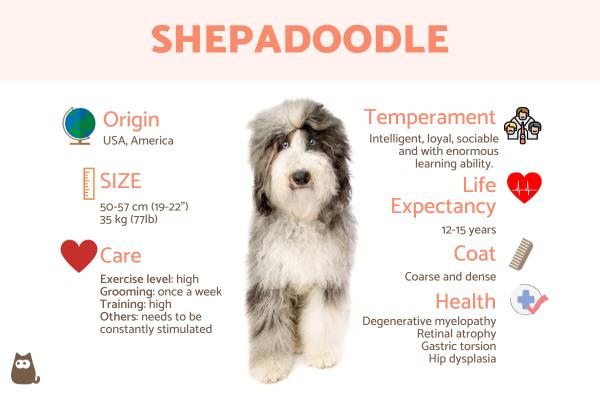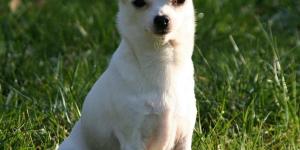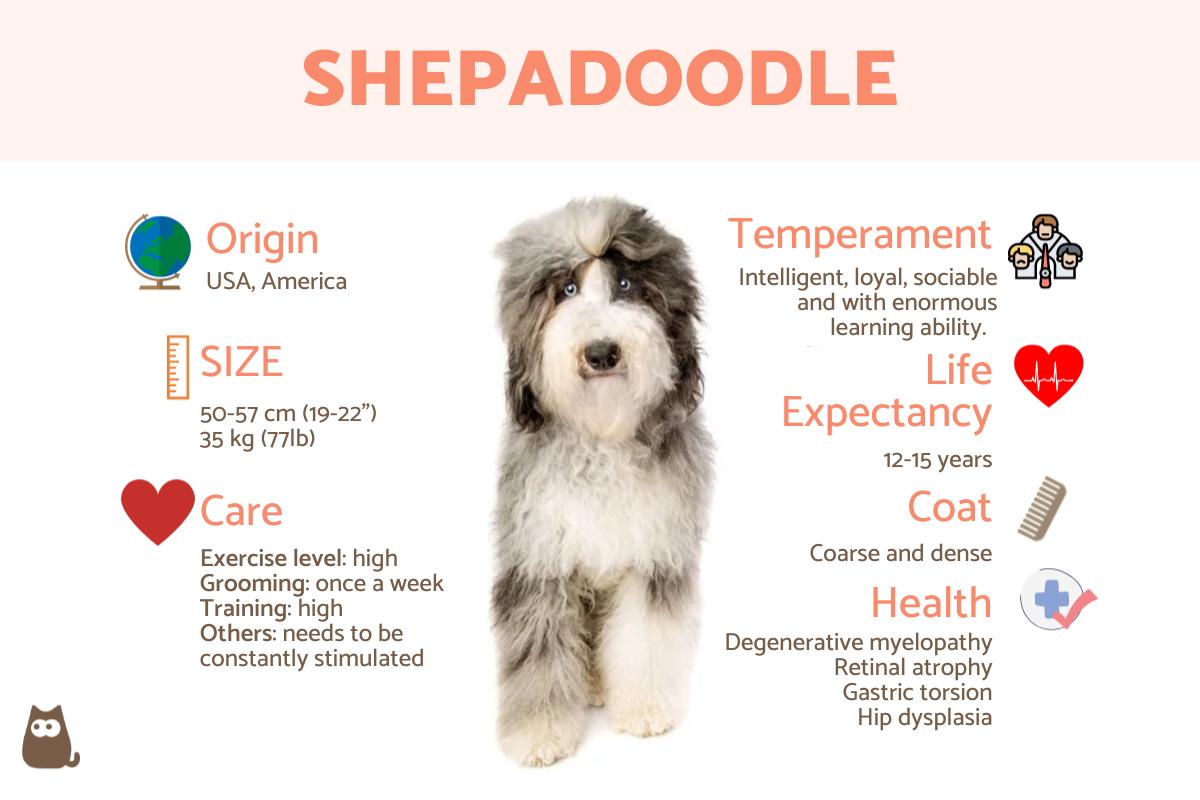Shepadoodle

The best designer dogs combine two of the best dog breeds in the world into one magnificent super dog that offers the best of both words. The Shepadoodle is one of those perfect hybrid pups, and you can probably guess its parentage from the name alone. Inherently smart, easy to train, and eager to please, this dog is a hybrid between two highly intelligent breeds, the German Shepherd and the Standard Poodle.
If you are thinking of adopting a Shepadoodle or just want to know more about this dog breed, read on. The following AnimalWised breed profile will tell you everything you need to know about the Shepadoodle dog breed, its origin, character, breeding, and health.
- America
- United States
- 5-14
- 14-18
- 18-22
- 22-27
- 27-31
- More than 31
- 2-7
- 7-22
- 22-55
- 55-100
- 100-220
- 8-10
- 10-12
- 12-14
- 15-20
- Low
- Meidum
- High
Origin of the Shepadoodle
German Shepherds and Belgian Shepherds were trained by the United States Army in the 1960s for military operations to be strong, active, and resistant to injury. However, they wanted to further improve the quality of canine agents and breed ever more powerful and intelligent specimens. Poodles were originally bred in Germany as water dogs for hunting waterfowl, while sheepdogs were for herding sheep. For this reason, they decided to cross German Shepherds with Standard Poodles, as the latter are characterized by their intelligence and great learning ability, as well as being nimble and fast dogs.
The result was the Shepadoodle, an exceptional working dog, which quickly enjoyed great popularity in the countryside and which today many people keep as a pet. Curiously, the Shepadoodle is not the only Poodle cross that made its triumph in the United States. Before this breed was bred, there were already other combinations, such as the Labradoodle (Labrador and Poodle) or the Goldendoodle (Golden Retriever and Poodle). Both breeds also became very popular and are often trained as assistance or therapy dogs.
Physical characteristics of the Shepadoodle
Shepadoodle specimens can be very different, as they are the result of crossing two pure breeds that also differ greatly in appearance: the German Shepherd and the Poodle. As a result, the dogs can vary in size, weight, appearance, and temperament. Some Shepadoodles resemble German Shepherds, with straight hair and heavier, more muscular bodies, while others resemble Poodles, with curly coats and lighter, leaner bodies.
Despite these differences, all Shepadoodles are large dogs, weighing an average of 77 pounds (35 kg) as adults and reaching a height of 50 to 57 inches (19 to 22 cm), with females being slightly smaller than males. The vast majority of specimens have large pendulous ears, a long tail covered with abundant hair, strong limbs, and round eyes that may be lighter or darker depending on coat color.
Shepadoodle coat colors
As mentioned before, there is no such thing as a typical Shepadoodle dog. These dogs may have the coarse, dense, black and tan coat that German Shepherds are known for, or a curlier, less hairy coat that is the trademark of their Poodle parents.
Moreover, the coat's color can vary greatly, including black, light brown, dark brown, cream, gray, white, and combinations of these colors. Since it is not an official breed, any color and pattern is accepted.
Temperament of the Shepadoodle
Although German Shepherds and Poodles differ in appearance, these breeds have some character traits in common. Both breeds were developed as working dogs and are valued for their intelligence, athleticism, trainability, and need for mental stimulation. As a cross between a German Shepherd and a Poodle, Shepadoodles embody all of these traits.
Shepadoodles are characterized by their intelligence and enormous learning ability. Therefore, it is important to cognitively stimulate this dog, either through training sessions or by providing challenges and activities that encourage them to think and solve problems. They are active and energetic dogs that love to play, exercise, go for long walks and play dog sports. In general, this dog loves the water and is a very good swimmer.
When properly socialized and all of its physical and cognitive needs are met, the Shepadoodle is a very sociable dog that is suitable for living with children and other animals, including cats. Shepadoodles are good at assessing people's sensitivities and weaknesses. They are cautious and mindful of when they should be close or when they require distance.
Shepadoodle are able to form a very strong bond with its caregivers and is a loyal and protective dog. Therefore, they do not like to be separated from their family for a long time, can be somewhat suspicious of strangers and tend to bark to warn of possible danger. This loyalty and defensiveness are what make them such good police and military dogs.
You may be interested in this other article, where we talk about the most common problems in dog training.
Care of the Shepadoodle
Like any other breed, the Schapendoes needs basic care to stay healthy and live a happy and long life
- Exercise: The Shepadoodle needs plenty of variety in their environment to stay stimulated and happy. Otherwise, they may develop behavioral problems due to stress, boredom, and frustration. Therefore, one of the most important concerns for the Shepadoodle is adequate stimulation, and not just at home. Since the Shepadoodle is such an active dog, it is important that they can exercise outside.
- Grooming: it is important to groom this dog's coat to prevent the formation of knots and dreadlocks that can affect the dog's health and prevent proper transpiration of the skin. Whether the dog has the coarse, straight coat of the German Shepherd or the curly, smooth coat of the Poodle, it is recommended that the coat be brushed and detangled at least once a week. Thanks to the genetic influence of the Poodle, the Shepadoodle does not shed as much, so coat care is easier. Because of the amount of hair on these dogs, it is essential to check the ears regularly and remove excess hair. If you clean the ears thoroughly once or twice a month, you will prevent the dog from getting a middle ear infection. This disease is relatively common, especially in Shepadoodles who like to swim in the sea or lakes.
- Nutrition: an innate characteristic of both breeds is a slight sensitivity of the stomach, and choosing a high-quality food is important. As an adult dog, your Shepadoodle should be fed 3-4 cups of high quality dry food daily. These dogs do not overeat and stay slim. This fact, combined with exercise, contributes to their healthy lifespan.
Training of the Shepadoodle
The Shepadoodle is a working dog. Therefore, Shepadoodles need enrichment to keep their minds sharp and fulfill their need for a task. Without tasks and challenges, your Shepadoodle may develop nervous habits. These anxious feelings can cause your dog a lot of emotional distress, and they may become disengaged with behaviors they know are wrong.
German Shepherds and Poodles are both highly intelligent breeds. So the Shepadoodle has dual intelligence. Shepadoodles aim to please their owners and complete tasks with flying colors. Your new Shepadoodle will look forward to training sessions and come out a winner in every class. They are good at remembering information and have a memory like an elephant. It will not take you long to teach your puppy basic commands and move on to more complicated tricks.
Ideally, the caregiver who adopts a Shepadoodle will have experience training dogs with high energy levels, be dynamic, and have plenty of time to devote to their dog. This breed is very adaptable and quickly understands what its caregiver is asking of it, as long as it is trained with a positive working method. When the Shepadoodle receives enough stimulation, he is very calm at home and enjoys resting with his family.
It is important that the Shepadoodle puppy be introduced to all types of stimuli in a gradual and controlled manner from the moment it comes home. Socialization with people, textures, sounds, animals and different objects prevents the appearance of fears and phobias and makes the dog a confident animal. To achieve this socialization, it is advisable to seek the help of a professional ethologist who can advise and guide the family, at least during the puppy phase.
If you want to learn more about how to train a dog properly, do not miss this other article, where we talk about the most common mistakes in training a puppy.
Health of the Shepadoodle
With proper nutrition, good exercise and regular vet visits, the Shepadoodle is a healthy and hardy dog that can easily live to be 14 years old despite its size. Nevertheless, this breed is prone to certain diseases due to the genetic heritage of its parents, the German Shepherd and the Poodle:
- Canine degenerative myelopathy: This neurodegenerative disease is commonly diagnosed in German Shepherds and results in weakness of the hind limbs as a result of progressive damage to the spinal cord. In its most severe stage, the hind legs can become completely paralyzed. Unfortunately, there is no cure for this disease.
- Progressive retinal atrophy: This hereditary eye disease causes irreversible degeneration of the dog's retina and almost always results in total blindness. It commonly occurs in poodles. Although there is no effective treatment for atrophy, it is slow, progressive, and painless, allowing the dog to gradually adjust to the loss of vision.
- Gastric dilatation and gastric torsion: This is a serious and life-threatening condition in which the dog's stomach fills with fluid and gas, expands and twists on itself, compressing other organs and arteries and obstructing blood circulation. The rapid intake of abundant food and/or water, followed by physical exertion, are risk factors for the occurrence of this phenomenon, especially in large and huge dogs. If you want to learn more about this condition, read this other article about gastric torsion in dogs.
- Hip dysplasia: very common in German Shepherds, this degenerative malformation of the hip joint causes lameness, pain, and difficulty walking. It can be diagnosed and treated by x-rays of the hip to stop its progression, although the final solution is to have the animal undergo surgery.
Some of the pathologies that commonly affect the Shepadoodle are hereditary. Therefore, breeders should not overlook the importance of knowing the medical history of the parent animals and testing them beforehand.
Where to adopt a Shepadoodle?
Despite its growing popularity, the Shepadoodle is still a little-known breed in some countries and is often confused with other crosses descended from the Poodle. However, it is not uncommon to find many mestizos in shelters that have been mistreated or abandoned by irresponsible people because they are unwanted litters. So if you are looking to adopt a Shepadoodle, it is best to look for rescue organizations that specialize in either German Shepherd or Poodle mix rescues.
In any case, remember that breed is not the most important aspect when adding a dog to your family. It is much more important that you are able to take responsibility for the dog's care and that it fits your lifestyle.
If you are interested in adopting a dog and have not decided on a specific breed yet, keep reading this other article, where we talk about all the benefits of adopting a stray dog.
Shepadoodle photos








